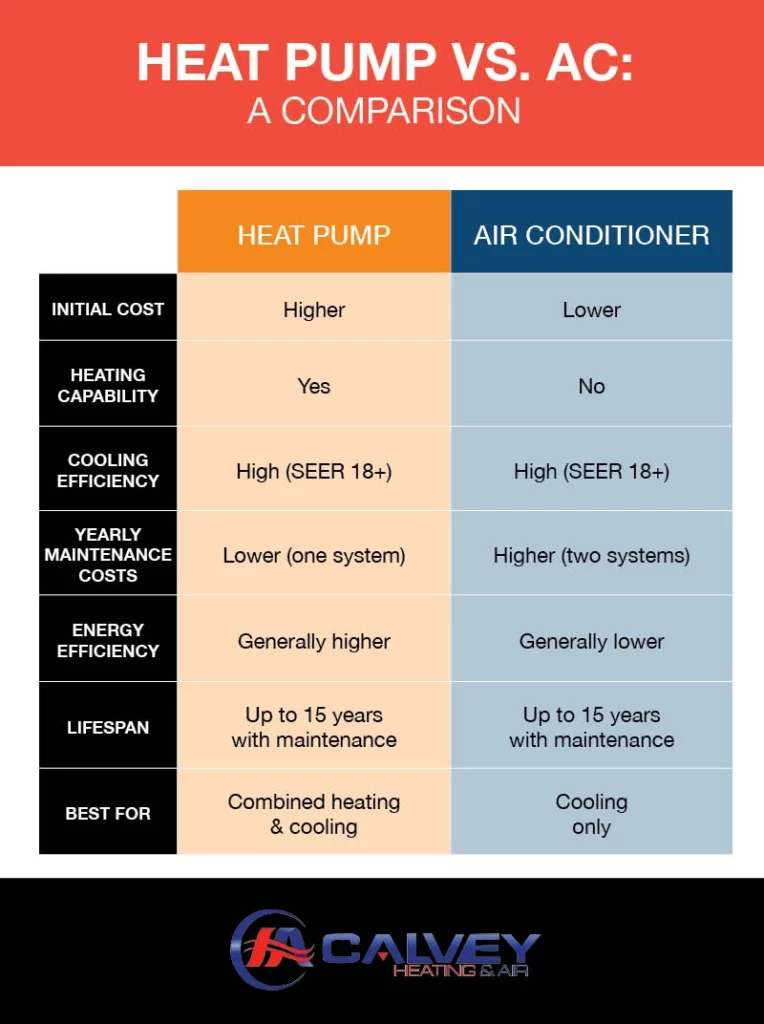Heat pumps are an economical and energy-efficient way to cool your Bay Area home. When well maintained, they use less energy than traditional cooling systems and can cool more effectively when properly sized and installed. Read on to discover more about how a heat pump cools a house so your home can be an oasis during the unforgiving heat of a San Jose summer.
Understanding How Heat Pumps Work for Cooling
Heat pumps use two units: an indoor unit and an outdoor unit. They work together to capture the heat indoors, turn the refrigerant to gas, and release it outside, turning the refrigerant back into liquid. This process is essentially the reverse of how your home is heated during the colder months.
Factors Affecting Heat Pump Cooling Efficiency
Many things can affect the efficiency of your heat pump. At Calvey Heating and Air, we perform a full home inspection before making any AC system recommendations. We’ll look at your house’s position on the lot, note any shade trees, and check the location of your doors. We’ll also look at your windows, attic, crawlspace, and basement for drafty areas, air leaks, and areas without insulation. Finally, we consider your home’s square footage and the layout of your rooms.
Poor insulation, single-pane windows, and a south-facing position without shade can all affect your unit’s efficiency. We can make recommendations to help improve the efficiency of your system at the time of installation, such as:
- Keeping the windows and doors closed while the system is running
- Closing the blinds during the hottest part of the day
- Setting the thermostat to 78°F when you’re home and 82°F when you’re away
Heat Pump vs. AC for Cooling: A Comparison

When comparing a heat pump vs. an AC for cooling your home, consider the cost to purchase and install, system efficiency, and yearly maintenance costs.
A heat pump can cost more upfront than an AC system, but it’ll also heat your home, meaning you only have to make one purchase rather than two. However, if your current AC is nearing the end of its life and your furnace still has many years left, it may not be economical for you to replace both with one unit.
Both systems are available with a high seasonal energy efficiency rating (SEER). In California, the minimum SEER for air conditioners and heat pumps is 15. High efficiency is anything with a SEER of 18 or higher.
Our heat pump customers enjoy the benefit of only having one system to look after, as opposed to a furnace and a separate AC system. This can translate to a decrease in maintenance and repair costs over time.
Benefits of Using a Heat Pump for Whole-House Cooling
A heat pump used for cooling helps you maximize your home’s energy efficiency through lower energy bills. Californians pay some of the highest energy rates in the country, and any opportunity to save on utility bills is welcome. Plus, your heat pump can last up to 15 years with regular maintenance.
Choosing the Right Heat Pump for Your Home
The right heat pump will meet your home’s heating and cooling demands. Smaller homes with a central corridor, like a classic 1970s Bay area rancher, may not have the space for a duct system. Choose a ductless mini-split heat pump to enjoy all the benefits without the bulk.
Despite their convenience, the ductless mini-split isn’t the best fit for all home layouts and sizes. Choose a standard heat pump with ducts and vents to enjoy even cooling throughout your home.
Whichever type you choose, look for about 20 to 30 Btus for every square foot. A 2,000-square-foot home requires between 40,000 and 60,000 Btus. Keep in mind that smaller units may overwork to compensate for demand, leading to frequent repairs and shorter service life. Too-large units may consume more energy than necessary.
Optimizing Heat Pump Performance During Summer
Calvey Heating and Air can help keep your heat pump working at its best throughout the summer with a spring tune-up. We pride ourselves on our quality work as a premium service provider. We’re known for our honest business practices, never selling you something you don’t need.
Our seasonal tune-up services start with a thorough inspection of your system. We’ll change the air filter (if needed), test electrical components, lubricate moving parts, and clean the system. If we uncover any potential issues, we can tackle the repairs immediately, saving you from experiencing an untimely breakdown in the future.
Change the air filter once every three to six months — more frequently during wildfire season and after dry, windy storms — to help keep your system running its best. This can help improve your indoor air quality and the system’s performance.
It’s also important to keep the area around the indoor and outdoor units clear and free of dirt and debris. Excess dirt can build up on the coils, leading to inefficient cooling and undue wear.
Quality HVAC Services You Can Rely On
Choose Calvey Heating and Air for your HVAC services. We’re family-owned and operated, serving South Bay, San Francisco, the Peninsula, and Mountain View areas. We offer transparent pricing, a 30-day warranty on our service calls, and a 3-year warranty on all our installations. Contact us to learn more or to schedule a service.


